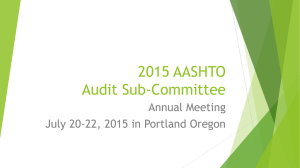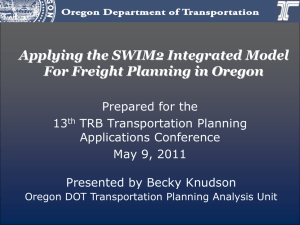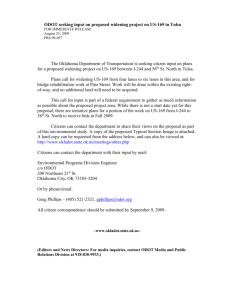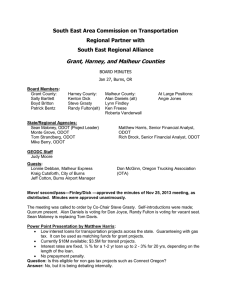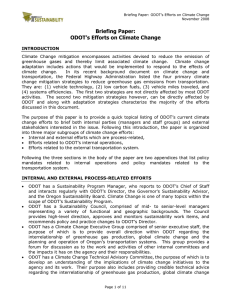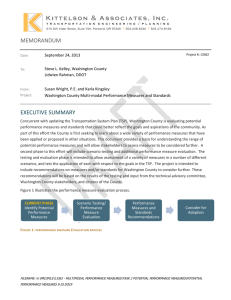Frank Angelo APG Legislative Presentation
advertisement
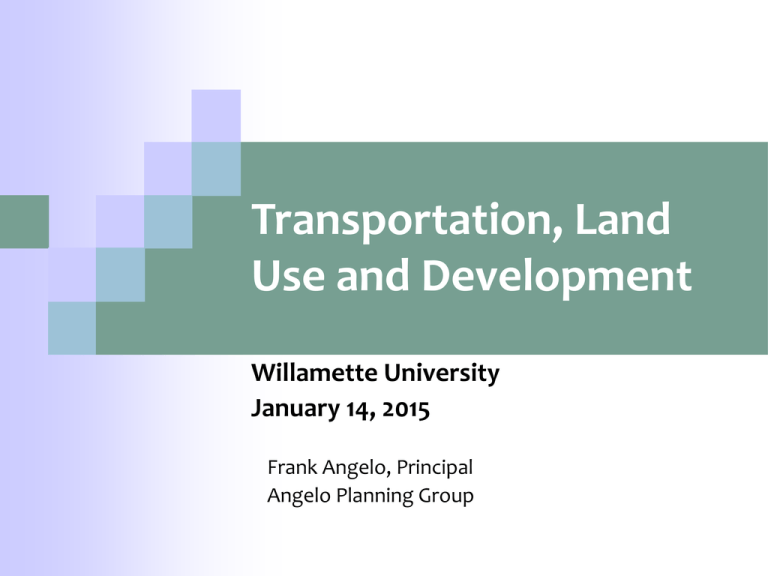
Transportation, Land Use and Development Willamette University January 14, 2015 Frank Angelo, Principal Angelo Planning Group Session Outline Land Use and Transportation Coordination State and Local Policy / Regulatory Context TSP, OTP, OHP, TPR, RTP, etc…… Relationship to Economic Development The Planning Process Land Development / Freight Emerging Issues Climate, Health, Active Transportation, Alternative Standards Land Use and Transportation Coordination – Why Plan? Balance between planned land uses and transportation improvements Implement local land use plans Establish project priorities Support economic development Protect community livability South Cooper Mountain Community Plan – APG Land Use and Transportation Coordination – Who Plans? State – Oregon Transportation Plan Establishes a statewide transportation vision Sets broad policy direction Describes coordination activities Includes investment priorities Includes modal plan elements Oregon Department of Transportation Flickr Photostream Land Use and Transportation Coordination – Who Plans? Metropolitan Planning Organizations (MPO) Urbanized areas of 50,000 population Ensure a continuing, comprehensive, and cooperative transportation planning process Forum for transportation decision-making Eight MPO’s in Oregon: Salem-Keizer; Corvallis Area; Albany Area; Central Lane; Rogue Valley; Middle Rogue; Metro and Bend Land Use and Transportation Coordination – Who Plans? Cities / Counties - Transportation System Plans Balance with local land use plans Set broad policy direction and coordination steps Create an implementation framework Zoning Codes Engineering Design Prioritize projects/identifies available funding Plan for various transportation modes Land Use and Transportation Coordination – What’s in a Plan? Most communities have Transportation System Plans that include: New roads and improvements to existing roads to meet 20-year needs Planning for walking/bike routes and improvements Zoning code standards for new development Funding for local improvements Planning for transportation options Streetmix.net Land Use and Transportation Coordination – How Plans are Used Define technical features of transportation system Set funding priorities and timing SDC’s, impact fees, vehicle registration, and local gas/property tax Zoning code amendments Maintenance, preservation, capital improvements Local finance options Road classifications and standards including bicycle, pedestrian, transit elements How development addresses the transportation system Coordination with other jurisdictions/agencies ODOT/MPO’s Transportation Funding Federal funding State funding – STIP Focus on maintenance and preservation Capital Projects Local funding options Traffic Impact Fees (TIF) / Systems Development Charges (SDC) Transportation Utility/Maintenance Fees Local Improvement Districts Local Option Taxes Some Shared Interests Urban and Rural Transportation Planning Access to markets: high tech, manufacturing, services, agriculture, forestry Access to Ports: distribution of products Employee access to jobs, work sites Access to recreation: recreation-based economies Transit – urban, rural and community based transit Safety improvements in key urban / rural corridors Rural Urban America – Huffington Post Project Example / Planning Lesson South Beach / Newport & US 101 Wilder/South Beach Village Center A village center that will provide: Create a sustainable community – 750 acre master plan Provide commercial and office-related uses to serve South Beach and Newport Support the Oregon Coast Community College (OCCC) and Hatfield Marine Science Center Create housing and jobs for Newport residents South Beach Concept Plan - APG Project Example / Planning Lesson State and Local Planning Concerns: Mobility constraints on US 101, exacerbated by the “pinch point” of the Yaquina Bay Bridge No funding in the 20 year planning horizon to widen or replace the bridge Forecasts indicated that US 101 in South Beach would not meet ODOT mobility standards Traffic demand forecasted to exceed highway capacity up to 8 hours per day during the summer peak period Yaquina Bay Bridge - Wikimedia Project Example / Planning Lesson ODOT, Newport, Lincoln County and property owners collaborated on a solution to: Match ODOT policies / standards with local aspirations (OCCC / South Beach Village) and economic and housing development goals Recognize physical and funding constraints (Yaquina Bay Bridge) Develop alternative mobility standards that led to a set of local and state transportation projects to enable development to proceed Phase transportation improvements to match development phases Aquarium Science Building, Oregon Coast Community College - DLA Design State and Local Policy & Regulatory Context Statewide program for land use planning since 1973 19 Statewide Planning Goals Achieved through local comprehensive planning Local comprehensive plans must be consistent with the Statewide Planning Goals Goal 12 addresses Transportation Planning Requirements Develop Transportation System Plans Local implementation of TSP State and Local Policy & Regulatory Context Transportation Planning Rule (TPR) Administrative Rule adopted in 1991 – amended in 1997, 2004/5 and 2011 Balance land use and transportation Plan transportation improvements to support land uses Plan local streets and alternative modes Make efficient use of limited public funding State and Local Regulatory & Policy Setting TPR Concerns: Perceived as an obstacle to economic development and compact urban development Perceived as an obstacle to compact development in urban centers Economic development objectives should be better balanced with transportation performance Difficult to increase development intensities, even though the statewide planning goals call for compact development Appearance of lack of coordination between land use, economic development, and transportation decision-making at the state level State and Local Regulatory & Policy Setting Amendments to TPR & Oregon Highway Plan (OHP) Exempt zone changes that are consistent with comprehensive plan map (TPR) Allow mitigation for economic development projects Exempt upzonings in urban centers Exempt proposals with small increase in traffic (OHP) Average trip generation assumptions Streamline alternate mobility standard development Corridor or area mobility standards State and Local Regulatory & Policy Setting TPR and OHP Amendments have: Clarified performance and mobility standards Provided more flexibility in application of standards Enabled compact development patterns where appropriate Provided support for projects that demonstrate economic development benefits Bend Central District MMA Relationship to Economic Development Importance of transportation facilities Attract and retain jobs Support freight dependent industries Provide geographic connections Remove barriers to economic growth Relationship to Economic Development Key Concerns: System Capacity – congestion Quality Capacity – congestion System Redundancy – alternative routes, freight Accessibility – interstate freeway and port access Competitive Factors – operating cost System Safety – hazardous conditions National Freight Network - US Department of Transportation Relationship to Economic Development Land Use and Transportation Planning Role Locating employment and residential areas – jobs / housing balance Getting people to work Getting goods to markets Providing alternative modes for work trips Identifying and prioritizing transportation connections to the Interstate System and Port facilities Some Emerging Issues Health related transportation issues Active transportation Greenhouse Gases (GHG) Equity Funding alternatives Transportation efficiency Some Emerging Issues Transportation/Land Use approaches to GHG Expand transportation options Create complete neighborhoods Expand intercity transportation options/choice Manage or reduce demand Support alternative vehicles Reinforce the themes of Oregon’s Land Use Planning Goals ODOT Greenhouse Gas Reduction Toolkit Emerging Issues Alternative Measures of Transportation System Performance – New Tools Mobility: travel time, delay on freight network Reliability: travel time index Accessibility: to key destinations, transit, bicycle facilities, and equitable accessibility Safety: critical rates Infrastructure: system completeness Summary Benefits of coordinating transportation and land use planning: Land uses can be balanced with and supported by transportation facilities Improvements to transportation facilities can be prioritized to support economic development and community livability Alternative transportation options can be planned for and encouraged Transportation facilities can be “right-sized” to meet existing and future demand for all types of users, including freight Questions and Discussion
